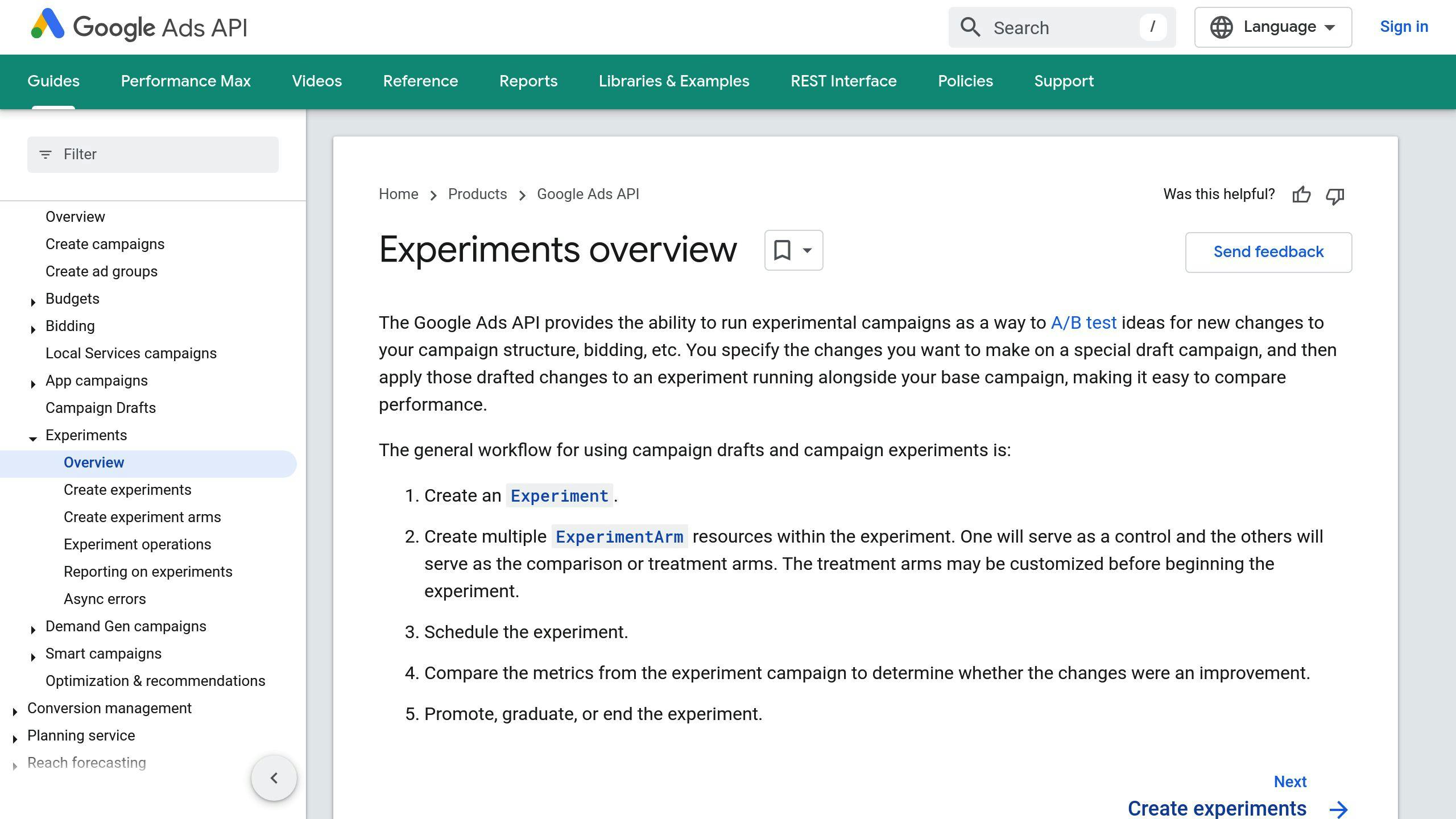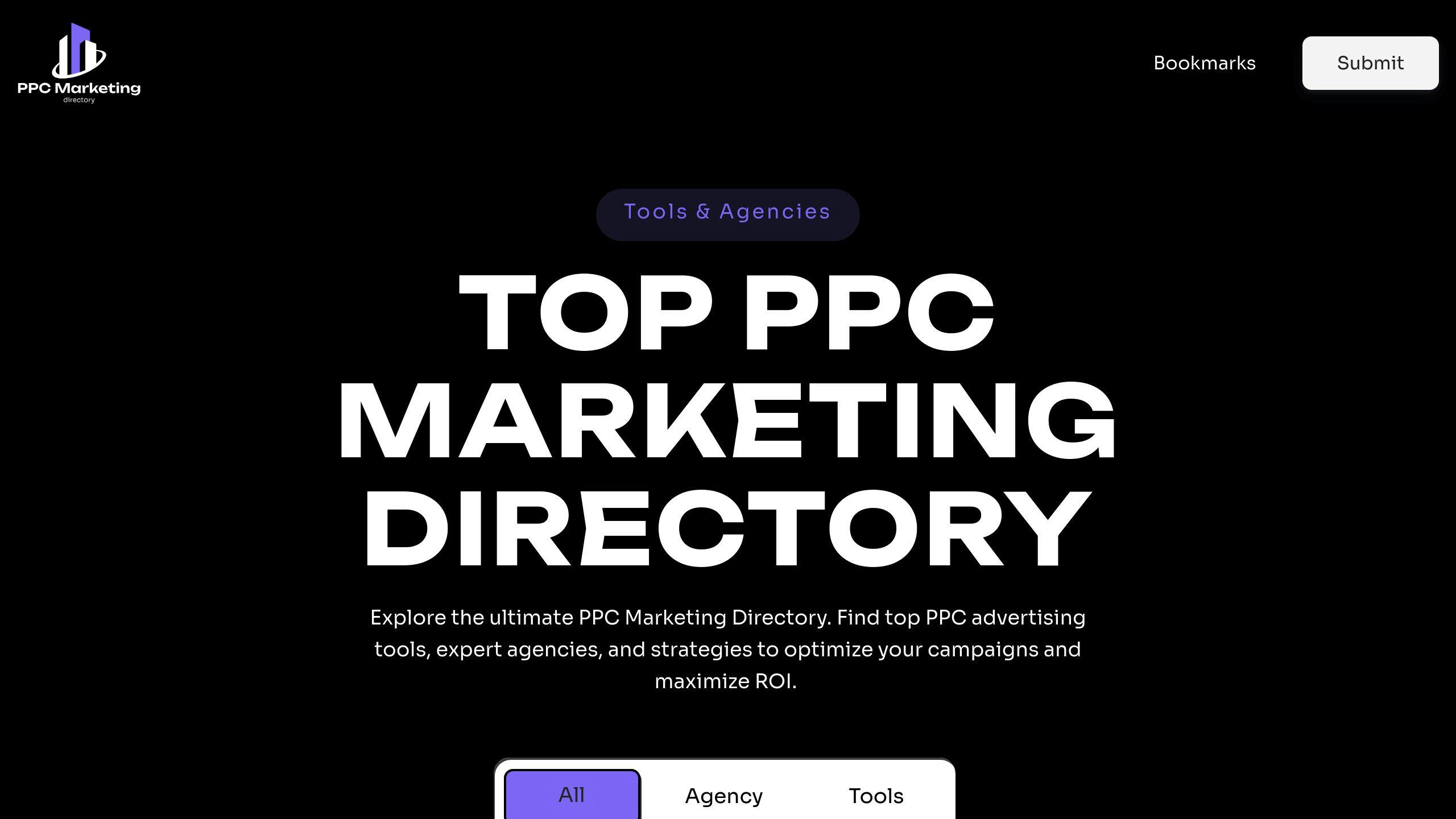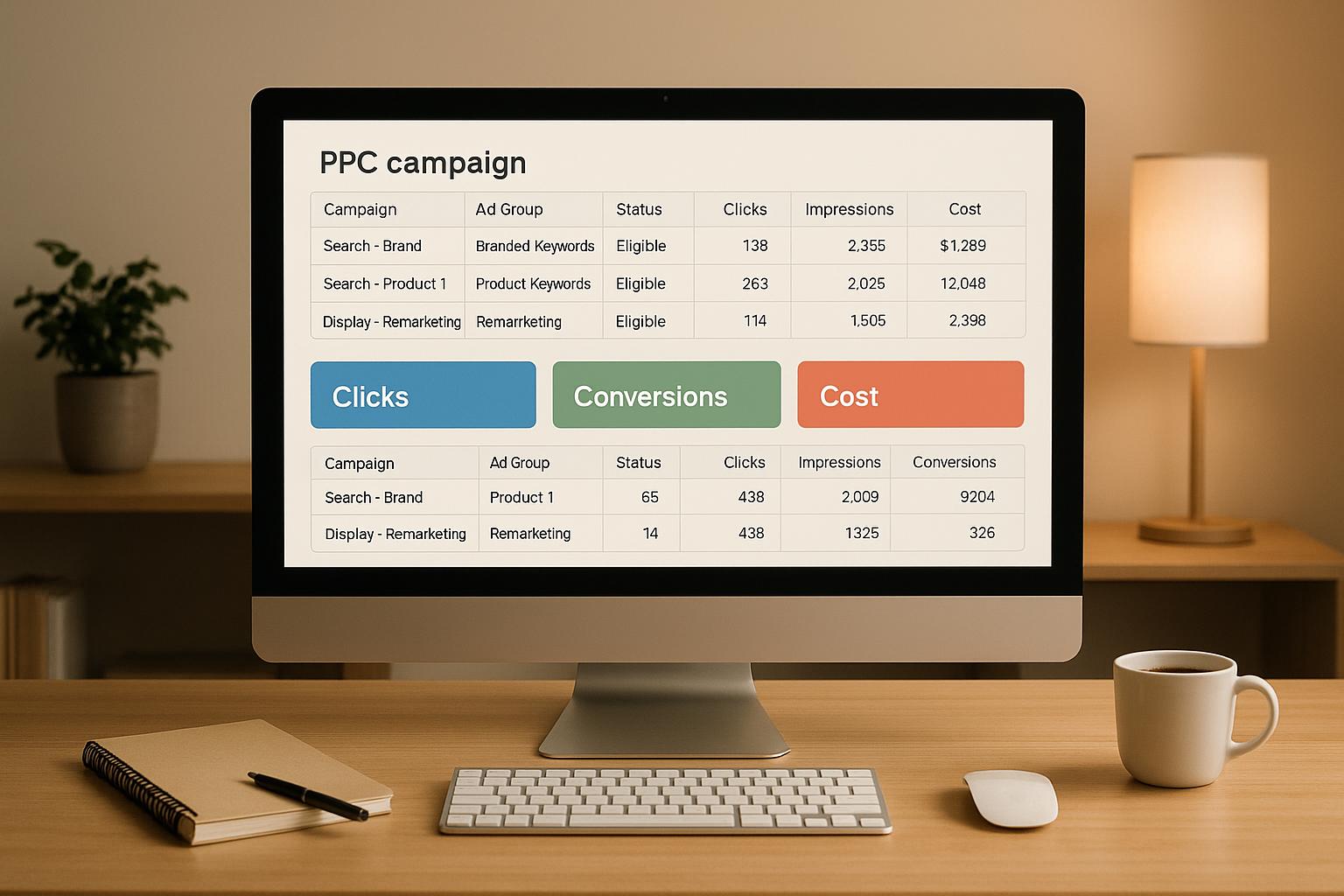Ad extensions in Google Ads enhance your ads with extra information, making them more engaging and effective. Here’s how to maximize their potential:
-
Types of Extensions:
- Manual Extensions: Customize features like sitelinks, callouts, and structured snippets.
- Automated Extensions: Google generates these based on your content.
-
Why Test Extensions:
- Improve performance by identifying what works best.
- Boost visibility and user experience.
-
Testing Methods:
- Use Google Experiments for A/B testing.
- Manually test by creating duplicate campaigns.
-
Key Metrics to Track:
- Click-through rate (CTR)
- Conversion rate
- Cost per conversion
-
Optimization Tips:
- Keep extensions updated and relevant.
- Test variations and refine based on performance data.
Ad extensions are free but require testing and regular adjustments to drive better campaign results. Use tools like SEMrush or Google Experiments to streamline testing and performance tracking.
Google Ads Extensions Explained (Tutorial & Real Examples)
How to Set Up Ad Extensions for Testing
Getting your ad extensions set up properly is key to running effective A/B tests, which we'll dive into in the next section.
Navigating to the Extensions Tab
Go to 'Ads & extensions' > 'Extensions' and use the 'All' dropdown to view different extension types. Here, you'll see a list of your current extensions, split into manual and automated categories, along with the option to create new ones.
How to Create and Assign Extensions
To start setting up extensions, head to "Ads & assets > Assets > +". Here's a quick guide for setting up some popular extension types:
Sitelink Extensions:
- Add URLs that lead to relevant landing pages and write short, clear descriptions to guide users.
- Use 2-4 active sitelinks per ad for better visibility.
Callout Extensions:
- Highlight key selling points in a concise format (25 characters max).
- Focus on specific features or benefits that set you apart.
Structured Snippets:
- Select a header that matches your category (e.g., "Types" or "Services").
- Include 3-10 values that make sense for your audience.
Tips for Setting Up Extensions
When configuring extensions, aim for relevance and a seamless user experience. Here are some tips to help:
Schedule Strategically: Use "Advanced settings" to control when extensions appear. This is especially helpful for:
- Time-sensitive deals
- Business hours
- Seasonal campaigns
Extension Placement: Apply extensions at the right level - account, campaign, or ad group - depending on your goals:
| Level | Best Used For | Impact |
|---|---|---|
| Account | Broad, brand-wide messaging | Affects all campaigns |
| Campaign | Targeted objectives | Focused on campaign goals |
| Ad Group | Specific audiences | Offers the most control |
Quality Guidelines:
- Keep your information up-to-date.
- Align extension content with your ad copy for consistency.
- Experiment with different combinations to find what works.
- Regularly monitor performance metrics.
Google will only show the extensions that are most likely to improve results based on user intent and ad position. Focus on selecting extensions that align closely with your audience and campaign objectives.
Once your extensions are live, the next step is testing their performance to ensure they deliver the results you're aiming for.
How to A/B Test Ad Extensions
Once you've set up your ad extensions, the next step is to test how well they perform. A/B testing helps you figure out which combinations are driving the best results for your campaigns.
Using Google Experiments for Testing

Google Experiments offers a controlled way to test ad extensions. Here's how to set up an experiment:
- Go to "Experiments" in your Google Ads account.
- Click "Create experiment" and pick the campaign you want to test.
- Set a traffic split (50/50 is a common choice).
- Adjust the extension variables in the experiment version.
Google will automatically track key metrics like CTR, conversion rates, and ROAS, making it easy to compare the results.
Manual Testing Methods
If Google Experiments isn't an option, you can manually test by creating duplicate campaigns. Here's a simple framework:
| Testing Component | Control Version | Test Version | What to Monitor |
|---|---|---|---|
| Extension Type | Standard sitelinks | Enhanced sitelinks | CTR, conversion rate |
| Content | Current messaging | New value propositions | Engagement metrics |
| Placement | Account-level | Campaign-level | Performance by segment |
Run these tests for about 30 days, changing only one variable at a time. This ensures you can clearly see which change is driving the results.
What to Test in Ad Extensions
Focus on elements that directly impact performance:
- Extension Types: Compare different combinations, automated vs. manual extensions, or beta features.
- Content Variables: Experiment with text length, call-to-action wording, or whether to focus on features or benefits.
- Placement Strategies: Look at device performance, location-based results, and time-of-day scheduling.
Keep an eye on metrics like CTR, conversion rate, and cost per conversion. These numbers will show you how users are engaging and whether your campaign is delivering a strong ROI. Regular analysis will help you find winning combinations to apply across your campaigns.
sbb-itb-89b8f36
How to Analyze and Improve Ad Extension Performance
Tracking Key Metrics
To evaluate how well your ad extensions are doing, focus on a few critical metrics. Click-through rate (CTR) is a key measure of how engaging your extensions are. Keep an eye on conversion rates to see which extensions are driving real results, and monitor impression share to ensure your extensions appear often enough to matter.
Here’s a quick guide to help you measure ad extension performance:
| Metric | What to Watch For | When to Take Action |
|---|---|---|
| CTR | Higher than the account average | Investigate if it’s 20% below your baseline |
| Conversion Rate | Equal to or better than ad performance | Adjust if it falls below your ad's rate |
| Impression Share | At least 80% for key campaigns | Take action if it drops below 70% |
| Cost per Conversion | Within your target CPA | Optimize if it exceeds your target by 15% |
Tracking these metrics is essential, but steering clear of common mistakes is just as important for getting the best results.
Common Mistakes to Avoid
One of the biggest missteps is overloading your ads with too many extensions. Stick to 2-4 extensions per ad to maintain a clean and focused presentation. Once you’ve addressed these issues, the next step is to refine your extensions using data insights.
Refining Extensions Based on Results
After analyzing your ad extensions, refining them ensures they align with your goals and continue to perform better. Here’s how to approach it:
- Spot your top-performing extensions across campaigns and ad groups.
- Test new variations: Use insights from successful extensions. For example, if "Free Shipping" works well, try "Same-Day Free Shipping."
- Replace underperformers: If an extension doesn’t deliver results after 30 days, swap it out with a fresh idea.
For structured snippets and callout extensions, focus on being specific and relevant. Avoid vague phrases like "Great Service." Instead, use clear claims like "24/7 Support" or "Same-Day Response" to improve engagement and communicate value more effectively.
Leverage performance data to fine-tune your targeting. For example, if location extensions perform better in certain areas, create versions tailored to those regions. You can also adjust scheduling based on what the data tells you, as outlined in the 'Tips for Setting Up Extensions' section.
Resources to Improve PPC Campaigns
Top PPC Marketing Directory

The Top PPC Marketing Directory is a go-to resource for tools that can improve your ad extension performance. This platform offers solutions to simplify A/B testing, making it easier to pinpoint which ad extensions work best without spending hours on manual adjustments.
| Category | Available Resources |
|---|---|
| Testing & Performance Tools | A/B testing platforms, analytics tools, ROI calculators |
| Extension Management | Automation software, scheduling tools |
| Campaign Optimization | Bid management systems, keyword research tools |
Beyond this directory, there are other platforms available that provide advanced tools for managing and testing ad extensions.
Other Helpful Tools and Platforms
Platforms like SEMrush and WordStream provide PPC analysis tools that can help fine-tune ad extensions. Studies show that well-crafted ad extensions can boost click-through rates by up to 20%. Additionally, Grow My Ads offers automated A/B testing, real-time performance tracking, and custom dashboards for analyzing extensions.
When selecting tools, focus on those with strong analytics and automation capabilities. These features can save time and make it easier to test and improve your ad extensions, ultimately leading to better campaign results.
With these platforms and tools, you’ll have everything you need to consistently improve your Google Ads campaigns.
Summary and Next Steps
Key Takeaways
The effectiveness of ad extensions hinges on keeping a close eye on metrics like CTR, conversion rates, and cost per conversion. A focused approach that combines strategic placement, thorough testing, and data-backed adjustments will yield the best outcomes.
Here are the main factors to focus on:
- Placement levels: Choose the right level for your extensions - account, campaign, or ad group.
- Testing tools: Make use of tools like Google Experiments or manual testing to refine your extensions.
- Accuracy matters: Keep price and promotion extensions updated to avoid misleading users and negatively affecting quality scores.
- Track performance: Regularly review performance metrics as discussed earlier in this guide.
Next Steps for Optimization
To refine your ad extensions and improve results, follow these steps:
- Audit your data: Identify extensions that aren't performing well.
- Test variations: Use tools like Google Experiments to experiment with different extension setups.
- Schedule strategically: Set up scheduling to maximize visibility during peak times.
- Adjust regularly: Monitor metrics and tweak your extensions based on performance trends.
If you're looking for additional resources, check out the Top PPC Marketing Directory. It offers tools specifically designed to help manage extensions and track their performance.
Keep in mind that testing and refining your extensions is not a one-time task. Regular updates and adjustments are crucial for maintaining strong campaign performance and driving better results over time. </
FAQs
What are Google ad extensions 2024?
Google ad extensions in 2024 are tools that boost ad visibility and performance without extra cost. They add details to make ads more engaging and effective. Recent updates highlight their importance in improving ad relevance, which can lead to better click-through rates (CTR) and lower cost-per-click (CPC).
How many ad extensions are in Google Ads?
Google Ads provides 12 types of ad extensions, which can be applied at the account, campaign, or ad group level. Here's a quick overview of some key types and their purposes:
| Extension Type | Purpose |
|---|---|
| Sitelinks | Link to additional pages |
| Callouts | Highlight special features |
| Structured Snippets | List specific details |
| Location | Display business address |
| Call | Show a phone number |
| Price/Promotion | Highlight costs or offers |
Google automatically chooses the best extensions for your ads based on factors like ad rank, user intent, and performance data.
To get the most out of these extensions, focus on ones that align with your campaign goals and testing strategies. This approach helps ensure they support your overall objectives effectively.


